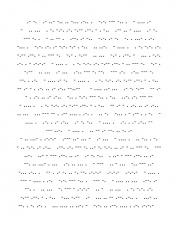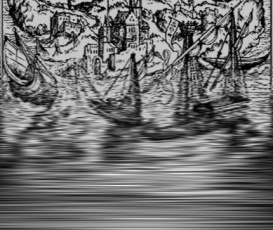User:Danny van der Kleij/Radio utopia
Danny, Radio Utopia, Trimester 6, 2012.
Radio Utopia
Description
An internet radio station based on the secluded utopian nature of the radio broadcast, At certain intervals the radio station will broadcast several methods of audible codes during a sound collage radio show. Listeners are enticed to decode the transmitted material and unravel the mysteries of a Radio Utopia.
A collage of sound fragments, pieces of spoken code placed within a radio utopia context, hints to where code's need to be placed, interviews on radio and its relation to utopia.
Instead of presenting a chronologically unified, coherent narrative, I will scatter pieces of the story across the Internet and other media, allowing players to reassemble it, supply connective tissue and determine what it means.
Media
Photos
Audio
Media:Numberstation.ogg
Media:You_have_landed.ogg
Media:Morsecode.ogg
Media:Isola.ogg
Essay
This thesis is primarily focused on the relationships between the notion of utopia and two devices used for electronic speech, namely the radio and the vocoder. This utopia is constructed out of contradictions rather than an unreachable social-politically perfect utopia. Considering radio as a utopian space, or rather a utopian moment within that space. Seeing radio as a distant and fleeting yet inescapable omnipresent broadcast. On the other hand the vocoder is a device that is concealing the voice, making the voice anonymous. The vocoder has a military secure speech history where the transmitted message is concealed and its users made anonymous, but it serves the same purpose in futuristic pop music vocals. How does the secluded notion of utopia relate to the idea of anonymity? The music that is made using the vocoder is usually a form futuristic nostalgia. These futuristic tendencies lead to the field of Afrofuturism where an alternative view on the space age is expressed via a form of music that most of all speaks on seclusion, as a metaphor for the position and history of the Afro American people. The history of the vocoder also leads towards other forms of cryptography within music, such as number stations and the Conet project as well as hidden messages within music.
Media:Danny_van_der_Kleij_Final_Thesis.pdf
References:
Anderson, B (2002) ‘A Principle of Hope: Recorded Music, Listening Practices and the Immanence of Utopia’ in Geografiska Annaler. Series B, Human Geography, Vol. 84, No. 3/4, Special Issue: The Dialectics of Utopia and Dystopia, (pp. 211-227) Blackwell Publishing
Baudrillard. J(1986) America (translated by Chris Turner) Verso.
Dickinson, K. (2001) 'Believe'? Vocoders, Digitalised Female Identity and Camp' in Popular Music Vol. 20, No. 3, Gender and Sexuality (pp. 333-347) Cambridge university press.
Dopp, B.J. (1994)’Numerology and Cryptography in the Music of Lili Boulanger: The Hidden Program in "Clairières dans le ciel" in The Musical Quarterly, Vol. 78, No. 3 (pp. 556-583) Oxford University press
Griffith Rollefson J. (2008) ‘The “Robot Voodoo Power” Thesis: Afrofuturism and Anti-Anti-Essentialism from Sun Ra to Kool Keith’ in Black Reseach Journal. Vol 28 No 1. Becoming Blackness and the Musical imagination (pp 83-109) University of Illinois Press.
Sams, E. (1968) ‘Music and Cipher’ in The Musical Times, Vol. 109, No. 1506 (p 730) Music Times Publications Ltd.
Segal, D. (Tuesday, August 3, 2004) ‘The Shortwave And the Calling’ in Washington Post (p C01).
Thompkins, D. (2010) How to wreck a nice beach, The vocoder from world war II to hip hop, The machine speaks, Stop Smiling Books.
Weadon, P.D. (2009) SIGSALY Story, http://www.nsa.gov/about/cryptologic_heritage/center_crypt_history/publications/sigsaly_story.shtml
Whitehead. G(1999) ‘Radio Silence’ in Merge number 4 (pp 39-41).
Bibliography:
Hilmes, M. (2005) ‘Is There a Field Called Sound Culture Studies? And Does It Matter?’ in American Quarterly - Volume 57, No. 1. (pp. 249-259) The Johns Hopkins University Press Johns, A. (2010) Death of a Pirate: British Radio and the Making of the Information Age, W. W. Norton & Company.
Whitehead, G. (1991) 'Holes in the Head: A Theatre for Radio Operations' in Performing Arts Journal, Vol. 13, No. 3. (pp. 85-91)
Whitehead, G. (1992) 'Out of the dark: Notes on the nobodies of radio art' in Kahn, D. & Whitehead, G. (ed.) Wireless Imagination, MIT Press
Whitehead, G. (1996) 'Radio Play Is No Place: A Conversation between Jérôme Noetinger and Gregory Whitehead . ' in Experimental Sound & Radio 40, No. 3 (pp. 96-101) MIT Press.
Music:
http://www.youtube.com/watch?v=3l-X-6OA_zE&feature=share&list=PLkWxMwCPHgbTMUL1uLrZ4HMPRkzpiety2
Additional Information
non optional
- One page itemised budget estimate
optional
- Project URL (if lives on an external site)
- extra wiki links (in case you have relevant notes/journals/documentation in your User: page, this is useful particularly if you have been asked to articulate further or refine your project during your assessment)
- Animated GIFs



